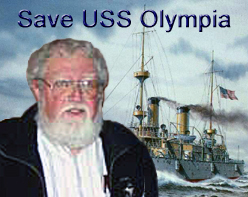
           |
USS Olympia, a protected cruiser built 1891-93 at the Union Iron Works in San Francisco, now lies at her permanent berth in Philadelphia. The 6,600-ton Olympia was part of the "New Navy" of modern warships which rejuvenated the U.S. fleet following a post-Civil War era of corruption, inattention and decay. Denoted C-6 (Cruiser #6), she came right at the beginning of this resurgence, along with the Maine and the 1895 Texas. She is one of the very few early steel warships preserved in the world today. Olympia is a graceful, balanced vessel, as evident in her plans and
a vintage 1898 shot. As the flagship of Commodore George Dewey at the Battle
of Manila Bay, in which the U.S. laid its claim to the Philippines within
days of declaring war on Spain in 1898, Olympia iced her own claim to fame:
Dewey's footsteps, cast in bronze, stand on her bridge to this day. The
cruiser carried four 8-inch guns in twin turrets fore and aft, a mixed
armament (ten 5" and smaller calibres) in casemate mountings and sponsons
on the hull, and 2 torpedo tubes. Olympia had a 40-year career in the Navy
and coast defense before becoming a museum ship in Philadelphia. The ship's
charter from Congress was to be built entirely by American industry and
in general she was a credit to her makers. However, there were a few awkward
features. As originally built, Olympia used a steam-operated training gear
for her 8" turrets (as did the Oregon and other American contemporaries).
This system lacked fine control, making it very difficult to train the
8" guns accurately. In target practice the gunners would send the turrets
around in a wide arc and fire as the guns bore. At Manila Bay, the ship
did most of her fighting with her 5" battery, although illustrators of
the day concentrated on the allure of the big guns. Post-1898 a more satisfactory
electrical training system was installed, copying the successful original
installation on the USS Brooklyn. Another design note was the experimental
use of cofferdams in the sides of the hull, packed with cellulose; this
was meant to provide lightweight anti-flooding protection. Also, coal bunkers
were sited along the ship's sides to absorb enemy shot; this proved potentially
dangerous as coal was prone to spontaneous combustion; it is thought that
a bunker fire next to a magazine may have caused the destruction of the
battleship Maine. Neither the cellulose nor the coal proved to be much
use as protection, though fortunately the ship survived her bouts of battle
without serious damage. No matter: Dewey was inflated into a first-class
American hero by the "Yellow Press" and politicos, and the Olympia and
her Captain Gridley shared the limelight. Coming only days after the declaration
of war, the Manila Bay victory etched itself on the national consciousness
in vivid colors. Consequently the ship has been quite well cared for by
the Cruiser Olympia Foundation and Independence Seaport Museum.
 
Who We Are How to Join Members Page HomePage Index Navy News Naval HistoryShip Locator Links FeedbackCredits NAVetsUSA Events Send comments to navetsusa@earthlink.net 
 |
||||

